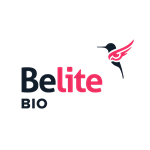- Tinlarebant (aka LBS-008) continues to be safe and well tolerated in adolescent Stargardt Disease (STGD1) subjects at the 18-month time point
- A continued trend of slowing expansion of autofluorescence was observed
- The growth rate of incident atrophic retinal lesions was reduced compared to a natural history study of the disease (“ProgStar”)
- Visual acuity was stabilized with no significant loss, and no clinically significant changes in retinal thickness observed over 18 months of treatment
SAN DIEGO, April 25, 2023 (GLOBE NEWSWIRE) -- Belite Bio, Inc (NASDAQ: BLTE), a San Diego based clinical stage biopharmaceutical drug development company focused on advancing novel therapeutics targeting retinal degenerative eye diseases which have significant unmet medical needs, today presented 18-month data from its ongoing two-year, open-label Phase 2 clinical study of Tinlarebant in adolescent STGD1 patients (“LBS-008-CT02”) as part of the poster presentation at the Association for Research in Vision and Ophthalmology (ARVO) Annual Meeting (Presentation: April 25th 8:45 am – 10:45 am, CST).
Professor John Grigg, the study’s Principal Investigator and Head of Specialty Clinical Ophthalmology at the University of Sydney and Consultant Ophthalmologist at the Sydney Children’s Hospitals Network at Westmead and Sydney Eye Hospital was the presenter of this interim study data. “It is great to observe that the 18-month interim data showed a consistent safety profile in patients treated with Tinlarebant,” said Dr. John Grigg. “Belite Bio’s current Phase 2 data also continued to demonstrate a promising trend toward slowing the disease progression in the study cohort.”
To date, twelve patients* have completed 18 months of treatment in the ongoing two-year Phase 2 study of Tinlarebant. Routine assessments were performed to evaluate safety and tolerability of Tinlarebant. Retinal imaging data have been collected for the evaluation of disease progression in all subjects. At Month 18, data from fundus autofluorescence (FAF) imaging revealed that nearly 60% of subjects (seven out of 12) showed no incident atrophic retinal lesions. Mean visual acuity was stabilized in the study cohort throughout the 18-month treatment period. Nine of 12 patients experienced mild xanthopsia/chromatopsia and delayed dark adaptation and one of 12 patients experienced night vision impairment, all of which were mild in severity and well-tolerated. A copy of the poster is available here (LINK).
“It is important to note that when compared with ProgStar study participants with only questionably decreased autofluorescence lesions at baseline, LBS-008-CT02 subjects exhibited a smaller increase (0.2 ± 0.1 mm2) in definitely decreased autofluorescence (DDAF) lesion size compared to ProgStar subjects (0.4 ± 0.3 mm2) after 18 months on study,” said Dr. John Grigg.
“We are very encouraged by the 18-month treatment results from our Phase 2 study as a majority of the subjects showed no transition to atrophic (DDAF) lesions, and in those subjects with transition to DDAF lesions, the DDAF lesion progression rate was slowed compared to a study of the natural history of disease,” said Dr. Nathan L. Mata, Chief Scientific Officer of Belite Bio. “The Phase 2 data presented at ARVO continue to reinforce that this investigational therapy could be a promising oral treatment for STGD1 patients.”
Belite Bio is currently conducting a two-year Phase 2 study and is enrolling patients in a two-year Phase 3 study (DRAGON) of Tinlarebant in adolescent STGD1 subjects and plans to begin enrolling patients in a two-year Phase 3 study (PHOENIX) of Tinlarebant in Geographic Atrophy (GA) in mid 2023. Belite Bio expects the next data readout in the Phase 2 STGD1 study to occur during the fourth quarter of 2023 when all subjects are expected to complete two years of treatment.
About DRAGON Study
The two-year Phase 3 study (DRAGON) is a Multi-Center, Randomized, Double-Masked, Placebo-Controlled Study to Evaluate the Safety and Efficacy of TinlaRebant in the Treatment of StArGardt Disease in AdOlesceNt Subjects. DRAGON is designed to evaluate the safety and efficacy of Tinlarebant in adolescent STGD1 patients. Approximately 90 patients are targeted for enrollment in this study with a 2:1 randomization (active:placebo). To date, Belite Bio has commenced this Phase 3 study in the U.S., the United Kingdom, Germany, Netherlands, France, Belgium, Switzerland, China, Hong Kong, Taiwan, and Australia. For more information, visit clinicaltrials.gov at https://www.clinicaltrials.gov/ct2/show/NCT05244304)
About Tinlarebant (aka LBS-008)
Tinlarebant is a novel oral therapy which is intended to reduce the accumulation of toxins in the eye that cause STGD1 and contribute to GA, or advanced dry AMD. These toxins are by-products of the visual cycle, which is dependent on the supply of vitamin A (retinol) to the eye. Tinlarebant works by reducing and maintaining levels of serum retinol binding protein 4 (RBP4), the sole carrier protein for retinol transport from the liver to the eye. By modulating the amount of retinol entering the eye, Tinlarebant reduces the formation of these toxins. Tinlarebant has been granted Fast Track Designation and Rare Pediatric Disease designation in the U.S., and Orphan Drug Designation in the U.S. and Europe for the treatment of STGD1.
Stargardt Disease
STGD1 is the most common inherited retinal dystrophy (causing blurring or loss of central vision) in both adults and children. The disease is caused by mutations in a retina-specific gene (ABCA4) which results in massive accumulation of toxic vitamin A byproducts (known as “bisretinoids”) in the retina leading to retinal cell death and progressive loss of central vision. The fluorescent properties of bisretinoids and the development of retinal imaging systems have helped ophthalmologists identify and monitor disease progression. Currently, there are no FDA approved treatments for STGD1.
Importantly, STGD1 and GA, or advanced dry AMD, share a similar pathophysiology which is characterized by the excessive accumulation of cytotoxic bisretinoids, retinal cell death, and loss of vision. Vision loss occurs slowly, despite peripheral expansion of “dead retina”, until the disease reaches the center of the eye (the macula). Therefore, Belite Bio intends to evaluate safety and efficacy of Tinlarebant in GA patients in its Phase 3 study (PHOENIX).
Geographic Atrophy
Dry AMD is a leading cause of vision loss in older adults. Geographic Atrophy, or GA, is the advanced stage of AMD. Currently, there are no FDA approved orally administered treatments for GA and no FDA approved therapies for the other stages of dry AMD other than GA. There are an estimated 20 million AMD patients in the U.S. and over 196 million patients worldwide with an estimated global direct healthcare cost of US$255 billion.
About Belite Bio
Belite Bio is a clinical-stage biopharmaceutical drug development company focused on advancing novel therapeutics targeting retinal degenerative eye diseases which have significant unmet medical needs, such as STGD1 and GA in advanced dry AMD, in addition to specific metabolic diseases. For more information, follow us on Twitter, Instagram, LinkedIn, Facebook or visit us at www.belitebio.com.
Important Cautions Regarding Forward Looking Statements
This press release contains forward-looking statements, about future expectations, plans and prospectus, as well as any other statements regarding matters that are not historical facts. These statements include but are not limited to statements regarding the potential implications of clinical data for patients, clinical development, regulatory milestones, and commercialization of its product candidates, and any other statements containing the words “expect,” “will,” “target,” and other similar expressions. Actual results may differ materially from those indicated in the forward-looking statements as a result of various important factors, including but not limited to Belite Bio’s ability to demonstrate the safety and efficacy of its drug candidates; the clinical results for its drug candidates, which may not support further development or regulatory approval; the content and timing of decisions made by the relevant regulatory authorities regarding regulatory approval of Belite Bio’s drug candidates; the potential efficacy of Tinlarebant, as well as those risks more fully discussed in the “Risk Factors” section in Belite Bio’s filings with the U.S. Securities and Exchange Commission. All forward-looking statements are based on information currently available to Belite Bio, and Belite Bio undertakes no obligation to publicly update or revise any forward-looking statements, whether as a result of new information, future events or otherwise, except as may be required by law.
Media and Investor Relations Contact:
Jennifer Wu /ir@belitebio.com
Tim McCarthy /tim@lifesciadvisors.com
* Our Phase 2 clinical trial of Tinlarebant in adolescent STGD1 initially enrolled 13 subjects in Australia and Taiwan. Among the 13 subjects, one subject in Australia was lost to follow up and therefore 12 subjects with complete 18-month data were evaluated.








